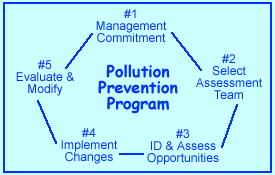Auto Body Shops Pollution Prevention Guide
#2 - Getting Started
GUIDE SECTIONS:

How do you start preventing pollution in your shop? Pollution prevention begins by thoroughly understanding your shop operation: the processes that
are used, the materials that are purchased, and the waste that is generated.
This can be done by designing a Pollution Prevention Program. Basically,
a Pollution Prevention Program describes your shop's waste streams, suggested
ways to prevent pollution, and implementation strategies and schedules.
The basic principles of designing a Pollution Prevention Program are outlined
in the figure on the left.
1 - Top Management Commitment
You must have a commitment from shop management from the beginning to prevent
pollution and to encourage all employees to participate in the Pollution Prevention
Program. A written statement is often the most effective evidence of this commitment.
Once you have guaranteed support from upper management, you have to get all
your co-workers committed to preventing pollution. It may help to set up a training
program that addresses source reduction, reuse, recycling, hazardous material
recognition and handling, and emergency response. And as a way to encourage
employee input, cooperation, and support, create an incentive program that rewards
co-workers for their input and participation.
2 - Select An Assessment Team
Once you have the commitment from upper management and your co-workers, consider
who will investigate the pollution prevention opportunities in your shop. A
Pollution Prevention Program can be designed and implemented by a single employee,
a team of employees, or an outside consultant. The team approach is highly recommended
not only because it is cheaper than hiring a consultant, but because each member
brings to the team a unique perspective and knowledge about what goes on in
the shop. Your pollution prevention team might include upper management, mechanics,
painters, clerical, custodial, and outside personnel (sanitation workers, local
recyclers, suppliers, government agencies, etc.). Next, your team should establish
a set of goals for the Pollution Prevention Program. For example, a goal could
be to eliminate the use of aerosol containers within a two-year period. Don't
forget to periodically review and update these goals. It is also the job of
the pollution prevention team to encourage employee participation and increase
awareness of your pollution prevention efforts. Keeping everyone informed can
help ease the natural resistance to change.
3 - Identify And Assess Pollution Prevention Opportunities
The next step is to use this guide to help you and your team identify:
- The types of materials used in your shop
- The processes that go on
- The activities that generate waste (remember, waste could be employee's time, air pollution, wastewater, energy loss, and non-hazardous and hazardous waste)
- The types and amounts of waste generated
- Economic feasibility
- Liability and Worker's Compensation
- Regulatory requirements
- Technical feasibility of switching to the alternative
- Reuse and recycling opportunities
- Disposal options (Pollution Prevention: A Guide to Program Implementation, 1993).
4 - Implement Changes
With your assessment team's pollution prevention ideas evaluated and identified,
you can now focus on implementing them. Start by developing an implementation
plan that discusses:
- What pollution prevention ideas will be used
- The costs associated with these ideas
- The payback period for each idea
- When these changes will occur
- A schedule for evaluating the entire Pollution Prevention Program
When you begin to implement your team's pollution prevention ideas, start with easy, low-cost, people-oriented changes. For example, good housekeeping can be the easiest and often the cheapest way to minimize waste and improve your shop's image with customers and employees. Good housekeeping includes keeping your reception and work areas clean, labeling containers, fixing leaks, and cleaning up spills right away. You may also find it easier to implement a few pollution prevention ideas at a time, especially if you are working on a tight budget. Keep track of how your pollution prevention plan works, noting what was successful and what was not. Be sure to notify all your co-workers when implementing pollution prevention ideas. It is very important to keep everyone informed about when you will be making a change, how the changes will affect them, and how your program is progressing. As a way of introducing new techniques or methods to your co-workers, consider holding pollution prevention training sessions.
5 - Evaluate And Modify
After your Pollution Prevention Program has been in place for a period
of time, it is a good idea to evaluate its successes and failures. Compare costs
before and after you implemented your program. You can consider your program
a success if you have, for example, saved money, reduced the amount of waste
generated, or reduced on-the-job injuries. If some ideas did not work, get your
assessment team together to come up with some solutions (Pollution Prevention:
A Guide to Program Implementation, 1993). As indicated in Figure 1, pollution
prevention is a continuous process, therefore you can evaluate and modify your
Pollution Prevention Program at any time. If you modify your program, remember
to notify your co-workers whenever there is a change that might affect them.
It is also a good idea to go back to the beginning of the program process and
recommit upper management to the new program and ideas.
As you complete each step in the Pollution Prevention Program planning
process, check it off the following list.
Pollution Prevention Program Checklist
|
#1 - Top Management Commitment
|
#2 - Select An Assessment Team
|
|
#3 - Identify and Assess Pollution Prevention Opportunities
|
|
|
#4 - Implement Pollution Prevention Ideas
|
#5 - Evaluate and Modify the Program
|


